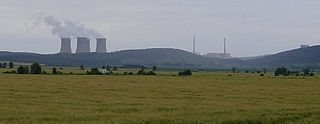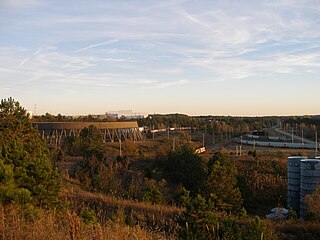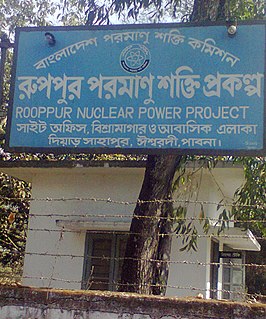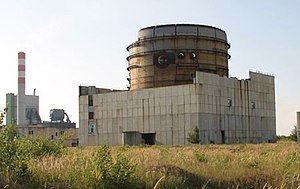
A nuclear power plant is a thermal power station in which the heat source is a nuclear reactor. As is typical of thermal power stations, heat is used to generate steam that drives a steam turbine connected to a generator that produces electricity. As of 2022, the International Atomic Energy Agency reported there were 439 nuclear power reactors in operation in 32 countries around the world.

The Chernobyl Nuclear Power Plant (ChNPP), officially the Vladimir Lenin Nuclear Power Plant, is a closed nuclear power plant located near the abandoned city of Pripyat in northern Ukraine, 16.5 kilometers (10 mi) northwest of the city of Chernobyl, 16 kilometers (10 mi) from the Belarus–Ukraine border, and about 100 kilometers (62 mi) north of Kyiv. The plant was cooled by an engineered pond, fed by the Pripyat River about 5 kilometers (3 mi) northwest from its juncture with the Dnieper.

The Alvin W. Vogtle Electric Generating Plant, also known as Plant Vogtle, is a two-unit nuclear power plant located in Burke County, near Waynesboro, Georgia, in the southeastern United States. It is named after a former Alabama Power and Southern Company board chairman, Alvin Vogtle.

A containment building is a reinforced steel, concrete or lead structure enclosing a nuclear reactor. It is designed, in any emergency, to contain the escape of radioactive steam or gas to a maximum pressure in the range of 275 to 550 kPa. The containment is the fourth and final barrier to radioactive release, the first being the fuel ceramic itself, the second being the metal fuel cladding tubes, the third being the reactor vessel and coolant system.

The advanced boiling water reactor (ABWR) is a Generation III boiling water reactor. The ABWR is currently offered by GE Hitachi Nuclear Energy (GEH) and Toshiba. The ABWR generates electrical power by using steam to power a turbine connected to a generator; the steam is boiled from water using heat generated by fission reactions within nuclear fuel. Kashiwazaki-Kariwa unit 6 is considered the first Generation III reactor in the world.

The AP1000 is a nuclear power plant designed and sold by Westinghouse Electric Company. The plant is a pressurized water reactor with improved use of passive nuclear safety and many design features intended to lower its capital cost and improve its economics.

Hartlepool nuclear power station is a nuclear power station situated on the northern bank of the mouth of the River Tees, 2.5 mi south of Hartlepool in County Durham, North East England. The station has a net electrical output of 1,190 megawatts, which is 2% of Great Britain's peak electricity demand of 60 GW. Electricity is produced through the use of two advanced gas-cooled reactors (AGR). Hartlepool was only the third nuclear power station in the United Kingdom to use AGR technology. It was also the first nuclear power station to be built close to a major urban area.

The water-water energetic reactor (WWER), or VVER is a series of pressurized water reactor designs originally developed in the Soviet Union, and now Russia, by OKB Gidropress. The idea of such a reactor was proposed at the Kurchatov Institute by Savely Moiseevich Feinberg. VVER were originally developed before the 1970s, and have been continually updated. As a result, the name VVER is associated with a wide variety of reactor designs spanning from generation I reactors to modern generation III+ reactor designs. Power output ranges from 70 to 1300 MWe, with designs of up to 1700 MWe in development. The first prototype VVER-210 was built at the Novovoronezh Nuclear Power Plant.

The Beloyarsk Nuclear Power Station was the third of the Soviet Union's nuclear plants. It is situated by Zarechny in Sverdlovsk Oblast, Russia. Zarechny township was created to service the station, which is named after the Beloyarsky District. The closest city is Yekaterinburg.

The Dukovany Nuclear Power Station is a nuclear power plant near Dukovany in the Czech Republic.
An unfinished building is a building where construction work was abandoned or on-hold at some stage or only exists as a design. It may also refer to buildings that are currently being built, particularly those that have been delayed or at which construction work progresses extremely slowly.

The Mochovce Nuclear Power Plant is a nuclear power plant located between the towns of Nitra and Levice, on the site of the former village of Mochovce, Slovakia. Two up-rated 470 MW reactors are presently in operation, with two further reactors of the same type under construction. Generating almost 7,000 GWh of electricity a year, the power plant currently serves approximately 20% of Slovakia's electricity needs.

Marble Hill Nuclear Power Station was an unfinished nuclear power plant in Saluda Township, Jefferson County, near Hanover, Indiana, USA. In 1984, the Public Service Company of Indiana announced it was abandoning the half-finished nuclear power plant, on which $2.5 billion had already been spent.

The Brennilis Nuclear Power Plant (EL-4) is a decommissioned site located in the Monts d'Arrée in the commune of Brennilis in Finistère, France.

Greifswald nuclear power station, also known as Lubmin nuclear power station, was the largest nuclear power station in East Germany before closure shortly after the German reunification. The plants were of the VVER-440/V-230 type, which was the second generation of Soviet-designed plants. The plant is in Lubmin near Greifswald, in the state of Mecklenburg-Vorpommern.

Rheinsberg Nuclear Power Station was the second nuclear reactor in East Germany after the Rossendorf Research Reactor, and the first nuclear power reactor in East Germany. It was built close to the city of Rheinsberg on the Stechlinsee. The power station was one of the first generation of demonstration power reactors.

Washington Nuclear Project Nos. 3 and 5, abbreviated as WNP-3 and WNP-5 were two of the five nuclear power plants on which construction was started by the Washington Public Power Supply System in order to meet projected electricity demand in the Pacific Northwest. WNP-1, WNP-2 and WNP-3 were part of the original 1968 plan, with WNP-4 and WNP-5 added in the early 1970s.

The Yellow Creek Nuclear Plant is a canceled nuclear power plant project near Iuka, Mississippi. It was originally planned to have two 1,350-MW (output) reactors operated by the Tennessee Valley Authority (TVA). The steam turbine-generator sets were provided by General Electric.

The Rooppur Nuclear Power Plant will be a 2.4 GWe nuclear power plant in Bangladesh. The nuclear power plant is being constructed at Rooppur (Ruppur), adjoining Paksey, in the Ishwardi Upazila of Pabna District, on the bank of the river Padma, 87 miles (140 km) west of Dhaka, in the northwest of the country. It will be the country's first nuclear power plant, and the first of two units are expected to go into operation in 2023. The VVER-1200/523 Nuclear reactor and critical infrastructure are being built by the Russian Rosatom State Atomic Energy Corporation. "Non-critical" infrastructure is being built by Bangladeshi and Indian construction companies such as the MAX Group of Bangladesh and the Hindustan Construction Company of India.
Shidao Bay Nuclear Power Plant, commonly known as Shidaowan, is a nuclear power plant in Shandong province, China. The site is located near the Xiqianjia village in Ningjin subdistrict, Rongcheng, Weihai, Shandong. The plant is located about 23 kilometres (14 mi) south of Rongcheng City, 14 kilometres (8.7 mi) northwest of Shidao, and 68 kilometres (42 mi) southeast of Weihai City.





















